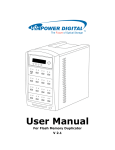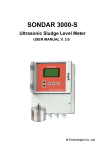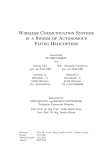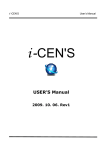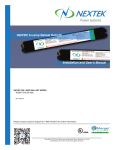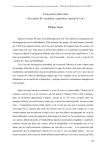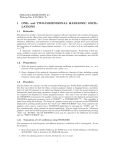Download Paper - Asee peer logo
Transcript
Reconfigurable Distribution Automation and Control Laboratory: A Network Reconfiguration Experiment for Load Balancing and Loss Reduction in Power Distribution Systems Xiaoguang Yang, Valentina Cecchi, Karen Miu, Chika Nwankpa Department of Electrical and Computer Engineering Drexel University Philadelphia, Pennsylvania Abstract – At Drexel University, a network reconfiguration experiment has been developed to provide students with hands-on experience on how to balance loads and reduce real power losses of a distribution system through network reconfiguration. The experiment has been set up within Drexel’s Reconfigurable Distribution Automation and Control Laboratory (RDAC) [1][2][3]. This paper discusses the Distribution Management System (DMS) module for students to acquire data, also to operate switches for network reconfiguration, and to perform loss calculations. Examples will be provided to show experimental procedures, system studies and data analysis performed by students. 1 Page 10.1061.1 1. Introduction and Educational Objectives In power distribution systems, loads may increase due to the installation of new customers and to the electricity demand shifts resulting from seasonal weather changes. Load increases not only cause higher power system losses but also may lead to overloads in electrical equipment, such as transformers and distribution lines, which will reduce the equipment’s lifespan. In order to reduce real power losses and relieve overload, network reconfiguration is performed. Network reconfiguration is a process of changing the topological structure of distribution systems by opening and/or closing normally closed (sectionalizing) switches and normally open (tie) switches. It can considerably improve system operating conditions by transferring loads from more heavily loaded feeders to less heavily loaded ones. This transfer of loads is called load balancing. As a result, the real power losses might also be reduced [4] [5] [6]. In addition, distribution systems are electrically unbalanced across phases (a, b, c), and it is known that unbalanced systems incur more losses than balanced systems. Hence network reconfiguration can also be performed to balance load across three phases using single-phase switching. For the above reasons, electric power utilities plan for the installation of network switches and perform network reconfiguration to balance loads and reduce losses. Therefore, it is very important to provide students with practical experience as well as theoretical analysis skills on network reconfiguration, specifically planning and operation techniques. At Drexel University, a network reconfiguration experiment has been developed to provide students with hands-on experience on how to balance loads and reduce real power losses using network reconfiguration. The objectives of this experiment include for the students to: 1) Understand the need for network reconfiguration for load balancing and loss reduction in a real-life environment; 2) Experience how to place new switches for network reconfiguration – planning; 3) Study how to schedule network reconfiguration for different loading conditions – planning and operation; 4) Understand how to select and operate existing three-phase or single-phase switches to reconfigure network– operation; 5) Gain experience with power flow analysis tools, estimation methods and loss calculations; 6) Evaluate advantages and disadvantages of different network configurations. The experiment is set up within RDAC which complements the generation and transmission oriented Interconnected Power System Laboratory (IPSL) at Drexel University [7][8]. RDAC consists of four modular stations that can be combined to form a distribution system with a total of 36 buses, 16 three-phase lines, 16 three-phase sectionalizing switches, 16 three-phase tie switches, and a number of various types of loads. A Distribution Energy Management System (DMS) has been developed to remotely control switches, to monitor the entire system, and to automatically acquire data with control and measurement facilities. This paper will present the details of the network reconfiguration experiment. It begins with a brief overview of the experiment in Section 2. In Section 3, various parts of the relevant power hardware are presented along with the measurement and digital control hardware. The DMS interface between the students and the distribution system is illustrated in Section 4. Then, an outline of the experiment is addressed in Section 5, followed by conclusions. 2. Overview of the Network Reconfiguration Experiment The network reconfiguration experiment provides students with hands-on learning experience concerning load balancing and loss reduction techniques through a series of experiments on different distribution systems. The experiment was developed within RDAC. RDAC consists of a three-phase, 4-wire, 43.2 kW reconfigurable distribution system and a DMS. A single-line diagram of RDAC is shown in Figure 1 for a typical setup. 2 Page 10.1061.2 Figure 1. One-Line Diagram Setup of the Reconfigurable Distribution Automation and Control Laboratory (RDAC) RDAC has four identical distribution stations. Each station has (i) a variable wye-grounded autotransformer (Variac) and a 30A three-phase circuit breaker for safety; (ii) a 9-bus distribution feeder with four three-phase sectionalizing switches and four three-phase tie switches; (iii) six multi-phase resistive loads and a three-phase capacitor, and (iv) a Remote Terminal Unit (RTU) with the DMS for data acquisition and digital control. Each station can run the experiment independently with groups of three to four students. By interconnecting the four stations using the tie switches, larger system experiments can be created for senior design projects and research-oriented studies. A general three-phase setup for the network reconfiguration experiment is shown in Figure 2. Figure 2. System Diagram for a Three-Phase Network Reconfiguration Experiment 3 Page 10.1061.3 In the experiment, 208V three-phase ac power is supplied by PECO Energy and fed to the 9-bus radial distribution system through an autotransformer. The radial system has two feeders with four three-phase lines. To develop different network configurations, four three-phase sectionalizing switches are embedded along the feeders. There are also four three-phase tie switches available, though only one is shown in Figure 2. These tie switches can be hardwired between any two buses excluding the feeder bus. It is noted that each phase of the sectionalizing and tie switches can be controlled separately for single-phase load balancing studies. At each bus, various resistive loads and a multi-tap capacitor can be connected. This allows students to perform network reconfiguration under different loading conditions. The RTU was built on a PC platform, including data acquisition and digital control hardware. During the experiment, it controls all of the sectionalizing and tie switches and measures three-phase and neutral voltages and currents at up to four buses. To provide an interface for students to run the experiment, a Distribution Energy Management System was developed on the RTU. Using the DMS, students can remotely operate the sectionalizing and tie switches to reconfigure the system. They can also obtain RMS values and phase angles of measured voltages and currents to assist them in estimating system states and real power losses. 3. Hardware Design The actual hardware setup on one RDAC station is shown in Figure 3. The setup consists of the following four main parts: 1) A power station providing three-phase 208Vac/120Vdc with a three-phase 1:1 autotransformer; 2) A distribution feeder box enclosing the 9-bus feeder; 3) A transfer station/light bank with four three-phase tie switches and multiple types of loads. Signal conditioning hardware is also installed under the transfer station in a National Instruments (NI) SCXI-1001 chassis [9]. 4) An RTU station with data acquisition and digital control hardware. Figure 3. Hardware Setup for the Network Reconfiguration Experiment The hardware most relevant to the network reconfiguration experiment will now be explained. 3.1. The Power Station and Autotransformer To perform the experiment, a 10.8 kW power station was built at each station [3]. It provides 208V three-phase ac power. It can also provide 120V dc power. For safety reasons, the ac power is fed through a three-phase wye-grounded autotransformer before entering the distribution feeder box, which is discussed next. 4 Page 10.1061.4 3.2. The Distribution Feeder Box The experiments are based on a 9-bus distribution feeder with • 4 three-phase distribution lines modeled using 12 1mH inductors; • 4 three-phase sectionalizing switches (normally closed) mimicked using 12 digital relays; • 4 possible three-phase tie switches (normally open) mimicked using 16 digital relays To realize this, an electrical system was designed and built within a distribution feeder box as shown in Figure 4. Please note that the tie switches are not embedded in the feeder box. They are part of the transfer station connected to the feeder box, which will be discussed later. The feeder is a reconfigurable three-phase system. Unbalanced systems with single-phase or two-phase sections can be created by opening the relays using the RTU. At each bus along the feeder, there are also: • Shunt connections to the transfer station for tie switch and load connections; • 4 hall-effect devices on all three phases and neutral for current measurements. Figure 4. 9-Bus Distribution Feeder Box with 20A Fuses for Protection 3.3. The Transfer Station and Light Bank A transfer station and a light bank were designed and developed to make connections for the tie switches and loads to non-source buses in the distribution feeder box (see Figure 5.a and Figure 5.b). The transfer station also allows for connections to other stations to create larger systems. On each transfer station and light panel, there are: • 8 floating buses for connections to 8 non-source buses on the feeder box; • 16 normally open digital relays mimicking four three-phase tie switches (a, b, c and neutral); • 6 transfer buses for connections to other three stations; • Multi-phase resistive loads (Figure 5.c) and 1 controllable multi-tap 3-phase capacitor. Figure 5.a Transfer Station Figure 5.b Transfer Station – Back View Figure 5.c Light Bank 5 Page 10.1061.5 Please note that the four three-phase tie switches can be connected to any of the eight nonsource buses on the feeder. For example, in Figure 5.a, it is shown that a tie switch is located between Bus A4 and Bus B4. Also, on the transfer station, various types of loads can be connected to the system conveniently. All the resistive loads, which are mimicked using carbon filament light bulbs, were hardwired from the light bank to the transfer station [10]. On each phase, there are five light bulbs connected in parallel with on/off toggle switches. Three-phase resistive loads can be configured in either wye or delta connection on the light bank. The threephase manual or remote controllable capacitor has three capacitor banks (15uF, 20uF, 25uF) in parallel on each phase, which provides 7 capacitor tap settings. 3.4. Measurement and Control Hardware In order to measure voltages and currents as well as to control the digital relays, signal conditioning, data acquisition and digital control hardware were integrated with the RTU. In the experiment, each station can measure three-phase voltages and currents (Va, Vb, Vc, Vn, Ia, Ib, Ic, In) at up to four buses with NI SCXI-1327 high voltage attenuators [11] and LEM LA- 100P hall effect current transducers [12]. Four 8-channel signal conditioning boards designed for Drexel’s Interconnected Power System Laboratory [7][8] were modified and used for signal attenuation, surge suppression, ground loop flow isolation and high frequency noise filtering. The 32 filtered signals were sampled at 60 samples per cycle per channel using a NI PCI-6071E data acquisition card (DAQ) [13] installed in the RTU. To perform network reconfiguration using the digital relays, 28 digital control lines were required. The DAQ card only has 8 digital input/output ports. Thus, two NI SCXI-1163 32channel digital output modules [14] were selected and controlled by two digital lines on the DAQ card. One digital control module operates the 12 closed relays in the feeder box. The other operates 16 open relays in the transfer station. With the designed power, measurement and control hardware from above, students can perform the network reconfiguration experiment in a real-life environment. In order to provide an interface for students to operate the hardware, a DMS was designed for each RTU. The details of the DMS are presented now. 6 Page 10.1061.6 4. The Distribution Energy Management System During the experiment, the distribution system is monitored and controlled through a DMS, which was developed using Microsoft Visual Basic 6.0 and NI Components Work [15]. The DMS provides students a platform for: • Visualization of experimental setups; • Remotely operating the sectionalizing and tie switches; • Automatic sampling of voltages and currents from up to four monitored buses; • Calculating RMS voltages, RMS currents, frequency, power and power factor on a cycle per cycle basis; • Displaying oscillographic and tabular data of voltage and current waveforms and power parameters. In general, the following system information is shown on the graphical interface of the DMS (see Figure 6): 1) A 208V ac source with a three-phase autotransformer servicing the system; 2) Green and red LEDs representing closed and open switches respectively 3) 4 three-phase sectionalizing switches (SW1 to SW4) and 4 three-phase tie switches (3-P Tie1 to 3-P Tie4). Please note that Figure 7 only shows one tie switch (3-P Tie 1); 4) 12 color coded inductors and resistors representing four three-phase distribution lines; 5) 4 sensors at each bus. The sensors on the selected measurement buses are highlighted; 6) The specified number and connection types of the loads hardwired in the system. Due to limited space, each three-phase tie switch is represented using one LED. The LEDs will become green if any phase is closed on the tie switch. Figure 6. Screen shot of the DMS for the Network Reconfiguration Experiment with 2 3-Phase Tie Switch and 4 Measurements on Feeder Bus, Bus A2, Bus A4, and Bus B4 The LEDs are interactive on the DMS. They allow students to remotely open or close any single-phase switch on the three-phase sectionalizing and tie switches by double clicking. If a LED representing a three-phase tie switch is selected, a window will pop up as shown in Figure 7 with four single-phase tie switches. Students can open or close each single-phase tie switch respectively. We note that before sending control signals to operate the actual relays in the system, the DMS runs a breadth-first-search [16] to determine the new network structure. The breadth-first7 Page 10.1061.7 Figure 7. Screen Shot of the GUI for Tie Switch Operation search method searches the connections of buses and branches from the source to the end of the feeder. If any loop is created by the switching operation, the DMS will not allow students to electrically operate the relays and the LEDs on the DMS will be restored to the original states. As previously mentioned, the DMS provides functions for students to view and analyze the power flow. The DMS automatically samples three-phase voltages and currents at up to four buses using the RTU. Using the sampled data, it calculates RMS values and phase angles of the measured voltages and currents. The DMS also calculates the real, reactive power and power factor using the voltages and currents. These power parameters are displayed in various forms: 1) Tabular form (See Figure 6); 2) Real time phasor diagrams (See Figure 8.a); 3) Oscilloscopic data (See Figure 8.a); 4) Instantaneous power plot (See Figure 8.b). To view the power parameters on each phase, students can click the sensors on the DMS. The data will be displayed in a window as shown in Figure 9. The students can also download all of the power parameters to Microsoft EXCEL files for further calculations such as real power losses, unmeasured bus voltages and line currents. Figure 8.a Oscilloscope View and the Phasor of ThreePhase AC Voltage Figure 8.b Oscilloscope View and the Phasor of Three-Phase AC Power Figure 9. Sensor Display of Bus B4, Phase A Voltage, Line Current and Power Page 10.1061.8 8 5. Experimental Outline With the designed hardware and software, a network reconfiguration experiment has been designed to meet the educational objectives discussed in Section 1. The experiment consists of pre-laboratory exercises, a laboratory module and at-home evaluations of results for report writeups. Within the laboratory module, three case studies have been developed to address the different requirements and objectives for network reconfiguration. They provide students with practical experience on network reconfiguration schemes in various networks and under different loading conditions: Case 1: three-phase switching in balanced and unbalanced networks Case 2: three-phase switching for various loading conditions Case 3: single-phase switching in unbalanced networks Through the experiment, students will: 1) Optimize locations of new tie switches for a given system in a pre-laboratory exercise; 2) Examine the scheme obtained in the pre-lab in an actual experimental setup and compare it with other schemes; 3) Analyze and determine a feasible network configuration scheme for various loading conditions; 4) Select and operate existing three-phase or single-phase switches to balance loads and reduce real power losses in different systems; 5) Estimate unknown bus voltages, line currents and real power losses. In the following subsections, each case will be discussed with graphical examples obtained from the DMS. For visual ease, all the figures show an enlarged view of the network diagram. 9 Page 10.1061.9 Case 1. Three-phase switching in balanced and unbalanced networks In distribution systems, most network switches are three-phase switches where all three phases of the switch are operated at the same time. As such, in Case 1, students will gain experience with improving load balance across feeders by employing three-phase switching and evaluating real power losses in at-home exercises for laboratory reports. More specifically, power distribution planning and operating issues are addressed where new switch installations and switching operations are determined under different load conditions. First, students perform switch placement for a system without tie switches in a pre-lab exercise. They are asked to determine where to install new tie switches in order to perform network reconfiguration. They must find appropriate placement schemes in order to balance feeder loads or according to a desirable voltage profile and/or real power losses obtained from power flow analysis. Then, students will test their selected scheme as well as alternatives in an actual experimental setup to verify their selection. Second, students will perform network reconfiguration with three-phase switching of existing three-phase sectionalizing and tie switches for the following different types of systems: 1) Three-phase balanced network with balanced loads; 2) Three-phase balanced network with unbalanced loads; 3) Multi-phase unbalanced network with 1-phase, 2-phase and 3-phase sections. In each system, two three-phase tie switches will be placed at fixed locations in the network (see Figure 6). Students will compare the possible network configurations and test each of them. By estimating the losses, and looking at the voltage profile, they will then draw a conclusion on which configuration is the most appropriate. For demonstration, a sample laboratory procedure is now illustrated for a Type 1 system. Beginning with the network configuration from Figure 6, two tie switches have been added one between buses A1 and B3 (3-P Tie 1) and another between buses A4 and B4 (3-P Tie 2). The following loading condition enumerated in Table 1 exists; though not shown here, visualization of Table 1 during the hardware experiment is achieved with bulbs on the light bank illuminated accordingly. Please notice that the bottom Feeder B has 8 times more load per phase than Feeder A. A new, more load balanced network configuration is shown in Figure 10, where the B2-B3 switch has been opened and the A1-B3 switch has been closed. Table 1. Resistive Loads for the System in Figures 6 and 10 # of light bulbs per phase on loaded buses Phase A Phase B Phase C Bus A4 1 1 1 B2 5 5 5 B3 1 1 1 B4 2 2 2 Figure 10. A Network Reconfiguration Scheme for the 3-Phase Balanced Network with Balanced Loads Having Two 3-Phase Tie Switches (3-P Tie1 and 3-P Tie2) at Fixed Locations 10 Page 10.1061.10 Case 2. Three-phase switching for various loading conditions In Case 2, students will perform tests to find an appropriate network reconfiguration scheme for different loading conditions. In distribution systems, loads may vary significantly in different seasons and network reconfiguration might be performed by electric companies to balance loads or reduce real power losses seasonally. However, switches should not be operated too frequently because it will reduce their effective lifespan. Hence, the system’s configuration may only be changed once for a certain set of loading conditions and an appropriate switching scheme is desired. During the experiment, students will perform network reconfiguration using the same set of three-phase sectionalizing and tie switches at fixed locations for all load settings. They will need to determine a switching scheme with minimum total real power losses for all load settings both prior to the laboratory and evaluate its performance after testing the network in the laboratory. If the losses from two or more schemes are close, students can analyze the voltage profile to select the most appropriate scheme. Case 3. Single-phase switching in unbalanced network In Case 3, students will balance loads and reduce real power losses by using single-phase switching. While the practice is not as common as three-phase switching, in some microgrid power systems such as shipboard power systems, the need for single-phase switching exists for a variety of reasons. Thus, it is important for students to gain exposure to and consider the benefits of single-phase switching techniques. In the experiment, students will operate single-phase sectionalizing and tie switches to balance loads on each phase in an unbalanced system. They will experience how to balance loads on individual phases existing on different feeders, in addition to, balancing load across three phases (a, b, c) on one feeder. An example is shown in Figure 11 where we start with a fixed tie switch and the loading condition given in Table 2. It can be seen that the loads on phase A at Feeder A is much larger than those on phase A at Feeder B while loads on phases B and C are balanced on both feeders. Table 2. Resistive Loads for an Unbalanced System # of light bulbs per phase on loaded buses Phase A Phase B Phase C Bus A2 4 3 1 A4 2 0 2 B2 1 2 3 B3 0 1 0 B4 1 0 0 Figure 11. An Unbalanced Network with Single Phase Sectionalizing and Tie Switches 11 Page 10.1061.11 Using single-phase switching, students can balance loads on phase A by transferring loads at bus A4 to Feeder B with the following steps: i) open the single-phase sectionalizing switch on phase A between BusA2 and BusA3 (SW2); ii) close the single-phase tie switch on phase A between Bus A3 and Bus B3 ( 3-P Tie 1). As a result, the loads become equal on phase A at both feeders and the three phases on each feeder are approximately balanced. The resulting network configuration is shown in Figure 12. Figure 12. A Network Reconfiguration Scheme for the Unbalanced Network using 1-phase Switching 6. Conclusions In this paper, the development of a network reconfiguration experiment is presented. From the experiment, students can gain exposure to planning and operation techniques for network reconfiguration. The experiment is developed in the reconfigurable distribution automation and control laboratory (RDAC) at Drexel University which provides a real-life experimental environment for the power distribution system studies. During the experiment, students create various (i) three-phase balanced, (iii) three-phase unbalanced and (iii) multi-phase unbalanced distribution systems under a variety of loading conditions. Thus, they experience realistic distribution power system operating scenarios. Using analytical methods, students determine switch placements prior to the laboratory; then, students test their placements and different network configurations for load balancing in the hardware laboratory. To remotely enable different network configurations, students interact with a distribution energy management system. The DMS also provides an easy-to-use graphical interface, power system monitoring functions, and data acquisition and capture for students to be able to perform subsequent calculations such as the effects of network configurations on real power loss. 7. References 12 Page 10.1061.12 [1] X. Yang, C. Bruni, D. Cheung, Y. M. Mao, G. Sokol, K. Miu and C. Nwankpa, “Setup of RDAC – a Reconfigurable Distribution Automation and Control Laboratory,” Proceedings of the 2001 IEEE PES Summer Meeting, Vancouver, CAN, July 16-21, 2001. [2] K. Miu, C. Nwankpa, X. Yang, A. Madonna, “Hardware Design and Layout of a Reconfigurable Power Distribution Automation and Control Laboratory,” Proceedings of the ASEE Annual Conference and Exposition 2002, Montreal, CAN, June 15-19, 2002. [3] K. Miu, C. Nwankpa, X. Yang, A. Madonna, “The Development of a Comprehensive Power Distribution System Curriculum,” Proceedings of the ASEE Annual Conference and Exposition 2003, Nashville, Tennessee, June 22-25, 2003. [4] H. D. Chiang and R. Jean-Jumeau, “Optimal Network Reconfigurations in Distribution Systems: Part 1: A New Formulation and A Solution Methodology,” Proceedings of the 1990 IEEE PES Winter Meeting, Atlanta, Georgia, February 4-8, 1990. [5] M. E. Baran and F. F. Wu, “Network Reconfiguration in Distribution Systems for Loss Reduction and Load Balancing,” Proceedings of the 1988 IEEE PES Summer Meeting, Portland, Oregon, July 24-29, 1988. [6] M. A. Kashem, V. Ganapathy and G. B. Jasmon, “Network Reconfiguration for Load Balancing in Distribution Networks,” IEE Proceedings Online No. 19990694. [7] S. P. Carullo, et al, “Interconnected Power System Laboratory: Fault Analysis Experiment,” IEEE Trans. on Power Systems, Vol. 11, No. 4, November 1996, pp. 1913-1917. [8] S. P. Carullo, C. O. Nwankpa, and R. Fischl, “Instrumentation of Drexel University’s Interconnected Power Systems Laboratory,” Proceeding of the 28th Annual North American Power Symposium, Cambridge MA, October 1996, pp. 367-376. [9] National Instruments, SCXI-1001 User Manual, Texas, 1996. [10] X. Yang, K. Miu and C. Nwankpa, “A Multi-Phase, Radial Power Flow Experiment for Power Distribution System Studies,” Proceedings of the 2004 IEEE PES, Denver, Colorado, June 6-10, 2004. [11] National Instruments, SCXI-1327 User Manual, Texas, 1997. [12] LEM, LA-100P User Manual, 2000. [13] National Instruments, DAQ-PCI E Series User Manual, Texas, 1997. [14] National Instruments, DAQ-SCXI-1163 User Manual, Texas, 1997. [15] National Instruments, NI-DAQ User Manual for PC Compatibles, Texas, 1995. [16] T. H. Cormen, C. E. Leiserson, R. Rivest, Introduction to Algorithms, McGraw Hill Book Co., New York, 1990. Page 10.1061.13 13














